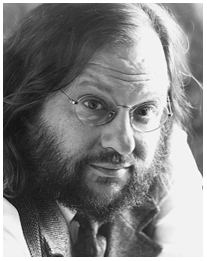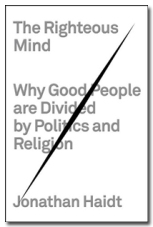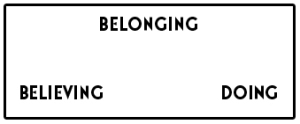Joel Lurie Grishaver
 Haidt, Jonathan. 2012. The Righteous Mind: Why Good People Are Divided by Politics and Religion. USA. Pantheon Books
Haidt, Jonathan. 2012. The Righteous Mind: Why Good People Are Divided by Politics and Religion. USA. Pantheon Books
I was raised in an education world where Jean Piaget was the sun. In that universe, Dr. Lawrence Kohlberg was the monarch of Moral Development. Much of my own work in Jewish values was predicated on Kohlberg. This essay is, in a way, a chance to begin again.
 Jonathan Haidt is a moral psychologist who studies the way the brain actually makes decisions. His new book, The Righteous Mind, is a look at ethical decision-making in light of brain science. The book is built on three metaphors. The first of the three is “The mind is divided like a rider on an elephant and the rider’s job is to serve the elephant. Think the evolved brain resting on the crocodile brain.
Jonathan Haidt is a moral psychologist who studies the way the brain actually makes decisions. His new book, The Righteous Mind, is a look at ethical decision-making in light of brain science. The book is built on three metaphors. The first of the three is “The mind is divided like a rider on an elephant and the rider’s job is to serve the elephant. Think the evolved brain resting on the crocodile brain.
Kohlberg suggested that children are moral philosophers who construct from idea of “harm” (that they experience as bad) to a concept of justice. Piaget watched children construct rules for playing marbles and concluded that children were rule makers. Rules went through growing complexity as children aged. Kolhberg applied Piaget’s developmental model to make the development of ethics a series of stages. Haidt debugs that and presents research that suggests that people ultimately make gut decisions about right and wrong. Thinking comes later. He says, “The elephant chooses its path” and reason, “the in-house press secretary,” (the rider) rationalizes those decisions. To firmly establish this he points out that morality shifts by culture.
This is the thinking-brain working with our primitive crocodile brain.
Judaism as a Civilization
Mordechai Kaplan wrote Judaism as a Civilization. Kaplan had a vision that understood that Judaism was a culture, a civilization—not merely a religion. He focused on those things that brought Israel together. He said that “we were a choosing people rather than the chosen people.” The nature of this community, their shared practices and values, were central to Kaplan’s understanding.
An individual is a person, when and because he knows himself as such; a group is a people, when and because it knows itself as such. (Mordechai Kaplan, Future of the American Jew, 1948)
While it is strange to expand an understanding of Kaplan by quoting his academic opponent Abraham Joshua Heschel, it is their confluence I want to show.
A few years back, Barry Shrage showed me a quote from Heschel that read, “The two words I never want to read again are ‘Identity’ and ‘Survey.’ Neither has anything to do with anything Jewish.”
“Who is a Jew?” A person in travail with God’s dreams and designs; a person to whom God is a challenge, not an abstraction. He is called upon to know of God’s stake in history; to be involved in the sanctification of time and in building the Holy Land; to cultivate passion for justice and the ability to experience the arrival of Friday evening as an event. “Who is a Jew?” A witness to the transcendence and presence of God; a person in whose life Abraham would feel at home, a person for whom Rabbi Akiba would feel deep affinity, a person of whom the Jewish martyrs of all ages would not be ashamed.
While Heschel is always theological and Kaplan sociological, what they hold in common is a dynamic and complex understanding of Judaism that is anything but reductionist. It is Judaism not as information, not as collection of individual practices, not as the right percentage of answers to a survey—but, Jewishness as a dynamic communal culture.
Identity, Continuity, Engagement and Less
Let’s talk about “Goal” words. Goal words are the way that people concentrate and express their targets. Goal words in Jewish life have always been interesting. Federated Jewish life has gone through a steady decline in the scope of these words. What began as “enculturation,” became “identity,” then “continuity,” and now is “engagement.” “Enculturation” is being wrapped in the blanket of a full culture. “Engagement” is little more than eye contact. Given smartphones, eye contact may be a lot to ask for.
The lesson of The Righteous Brain is that culture and ethical decision making are intertwined. If, you care about Jewish ethics (and not just liberal ethics with a Jewish quote) then it has to come culturally. They come with mitzvot, Biblical literacy, Hebrew poetry, food, and a whole host of other factors. Think of how a Passover Seder screams “freedom.” This doesn’t mean that Jews have to become religious, but they have to be wrapped snugly in Jewish culture. Hayyim Nahman Bialik got this when he and Ravnitzky created Sefer Ha-Aggadah whichis an all-encompassing collection of rabbinic stories.
The simple truth is that less is less when we come to Jewish education and that despite fiscal and physical needs that make keeping the doors open, we have some questions to face about diminishing returns. When is too little not enough?
I am not standing on the top of the mountain here, and looking down. I want to make it very clear that I too worship at the altar of practicality. What I write today is not the same as what I once would have written. The changes I make are influenced by the choices made on the frontiers of Jewish life. I don’t get to decide what schools look like. I don’t directly face the Jewish people and I deal only indirectly with their desires. I don’t have a stack of pink phone notes and dozens of angry e-mails when I read my desk in the morning. I have learned to accept that there are things over which I do not have power, but in the darkness of night, in the edge of sleeplessness, I still wonder about my own actions. I worry about what is left after I have minimalized it.
Metaphor Two: Morality is Like Taste
Jonathan Haidt introduces the term “WEIRD”–Western Educated Industrial Rich Democratic. Until recently, almost all experiments in moral development were conducted within the WEIRD. And, unfortunately, or perhaps fortunately, most of our students (and their parents) are WEIRD, too.
Haidt’s second metaphor is that morality is a lot like taste. Just as we have a number of different taste receptors on our tongues (sweet, sour, salty, umami, and bitter). Most liberals use only the first two of these receptors (that Haidt calls “the Foundations”). Conservatives tend to use all six. So do most people who are non-WEIRD.
These foundations are:
- care/harm
- liberty/oppression
- fairness/cheating
- loyalty/betrayal
- authority/subversion
- sanctity/degradation
Care/Harm. The Jewish tradition (both Jewish law and the lessons of Jewish history) is committed to the care/harm foundation. This is very key to Kohlberg’s Moral Development. It stems from “one who saves one person is like one who saved the whole world.” It is all of our Tikkun Olam goals.
Liberty/Oppression. Liberty is a value that Jews have come to adopt. I am honestly not sure where the Jewish origins of the liberty connection are, despite “Proclaim liberty throughout the land (Leviticus 25:10).” Passover is the Egypt/anti-slavery foundation. We buy heavily into that value area (but we have our own language for it) . We are very anti-oppression. It is all wrapped up in the word “Egypt,” then shifts to “Haman” and “Holocaust.”
Fairness/cheating. Fairness/cheating is also a big Jewish value complex. This is also the bridge foundation that liberals buy into but nowhere as strongly as conservatives. For Jews this is in a file drawer labeled “fair weights and scales.” It is why we are so strong on business ethics. If you worry less about welfare cheats and more about getting help to those who need it, you do not have this foundation as a central value. (I don’t either!)
Loyaty/Betrayal & Authority Subversion. Theloyalty/betrayal foundation and the authority/subversion foundation also have deep Jewish roots. Traditional Judaism felt it was wrong to ever turn a Jew over to a non-Jewish court. It was a loyalty issue. We label it a “Jewish People” thing. But, while these values still have root (sometimes inappropriately) in the extreme Orthodox community, they have less application in the Reform, Reconstructionist, and Conservative communities. If these foundations don’t make sense to you, think about the fuss over Obama and a flag pin. It was an American version of the intermarriage issue. These two foundations are where Rabbi Mordechai Kaplan did much of his work. It is the heart of the JCC movement where you pay to work-out next to other Jews. Kaplan invented the JCC, the Havurah, and a lot of other communal processes.
Sanctity/Degradation. Sanctity/degradation can better be understood as holy and profane. These are core religious values that are very at risk in the WEIRD world. Since 9/11 there have been some interesting changes to Western religiosity. Conservatives reacted by saying that “Islam was anti-peace.” This got modified by liberals to “Moslem Fundamentalist are evil.” This soon became “all fundamentalists are all evil.” And in for many of our kids as, “all religion is evil.” “The New Atheists,” Sam Harris, Richard Dawkins, Daniel Dennett and Christopher Hitchens” have grown in popularity. This is where Bill Maher likes to dwell. It is the heart of Religilous. (http://www.imdb.com/title/tt0815241/ )
Fewer of our kids now believe in God than have believed in God in a long time. 9/11 put us in a post-post-modern context with belief in, and a rejection of, science—both at an all-time high. The real challenge here is to get our students to perceive the category of the sacred. Or as Lawrence Kushner once taught, “It is not so important to ask our students if they believe in God, but to get them to share one time when they felt close to God.
Metaphor Three: Morality Binds and Blinds
Haidt’s last metaphor is: We are ninety-percent Chimp and ten-percent Bee. Simply put, chimps have no sense of cooperation. They may mate, but they are loners. Bees have the “hive mentality” thing. People are “Homo Duplex,” they function alone but also can seriously do the “group thing.” Most often the group thing functions as “we vs. them” (Go Red Sox), but it need not go that far. Humans have what Jonathan Haidt calls a “hive switch” where the power of being a group member overcomes our usual preference for individuality.
Haidt says, “Religion is a team sport.” We know that already. That is why Jewish community and classroom community need to be such a big deal for our schools. We need for our students to be together (1) long enough and (2) in such a way that they bond together.
We get the Homo Duplex thing, “If I am not for myself, who will be for me? And when I am only for myself, what am ‘I’? And If not now, when?” (Hillel, Pirke Avot 1:14)
Haidt suggests that religion is a triad:
We also get that. Judaism is a combination of the three. When we work on belonging, we are building a path towards the other two. We need to move our clients from aloneness to friendship, and then from friendship to belonging. That is the path to Jewish survival.
The Three Metaphors
The lessons from The Righteous Mind are locked in its three metaphors:
[1] The Brain is like an Elephant with Rider. Reason is the rider, gut feelings are the elephant. The elephant decides where it is going; the rider tries to keep it out of trouble. We decide most things in our gut and then our reason rationalizes them. The major way to influence the decisions the elephant makes is to wrap them in culture. Our schools need to provide a rich, unique culture.
[2] Morality is Like Eating. The tongue has five different kinds of taste buds. Our morality has six kinds of foundations. Liberals only use two and a fraction of these. People who are not WEIRD or who are conservatives use all six. Our job is to expand our students’ ability to taste. We are to treat them with experiences from the other four other foundations. The “sacred” is the most important of these other receptors. Non-fundamental holiness is our challenge.
[3] Humans are Ninety-percent Chimp and Ten-percent Bee. People are individuals, but they have a “hive switch.” If we can flip this switch by building community, we create an import part of the belonging, believing, acting triad. For Jews, action is the second step. When we act as a community we build faith.
This is a great book. I learned a lot from it. I really recommend it. There is a lot that Jewish educators can learn from it.


